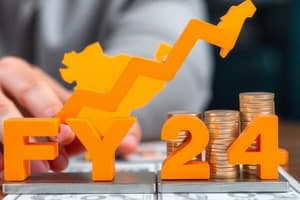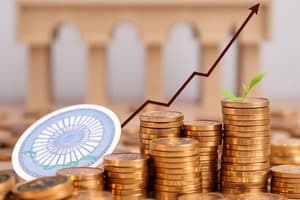Podcast
Questions and Answers
What components make up Aggregate Demand (AD)?
What components make up Aggregate Demand (AD)?
- Consumption, Investment, National debt, and Imports
- Consumption, Fixed capital formation, Tax revenue, and Exports
- Consumer savings, Private investment, Government bonds, and Exports
- Consumption, Investment, Government spending, and Net exports (correct)
What effect does a decline in the price level generally have on Aggregate Demand?
What effect does a decline in the price level generally have on Aggregate Demand?
- It decreases Aggregate Demand due to reduced consumer confidence.
- It increases Aggregate Demand as consumers are able to purchase more. (correct)
- It has no significant impact on Aggregate Demand.
- It leads to a decrease in savings, reducing Aggregate Demand.
What typically causes the Aggregate Supply curve to shift?
What typically causes the Aggregate Supply curve to shift?
- Technological advancements and productivity improvements (correct)
- Changes in consumer income levels and spending habits
- Inflation rates and consumer preferences
- Government regulations and tax policies
What happens when Aggregate Supply (AS) exceeds Aggregate Demand (AD) in the short run?
What happens when Aggregate Supply (AS) exceeds Aggregate Demand (AD) in the short run?
Which of the following does NOT represent a component of Aggregate Demand?
Which of the following does NOT represent a component of Aggregate Demand?
What defines potential real GDP growth?
What defines potential real GDP growth?
What is GDP growth often affected by in the short run?
What is GDP growth often affected by in the short run?
Which phase follows recovery in a business cycle?
Which phase follows recovery in a business cycle?
What happens during the slowdown phase of a business cycle?
What happens during the slowdown phase of a business cycle?
Why might actual real GDP growth deviate from potential real GDP growth?
Why might actual real GDP growth deviate from potential real GDP growth?
What is a characteristic of business cycles?
What is a characteristic of business cycles?
What may cause a country to experience higher GDP growth in the long run?
What may cause a country to experience higher GDP growth in the long run?
What is the effect of mismatches in demand-supply on GDP growth?
What is the effect of mismatches in demand-supply on GDP growth?
What characterizes the peak phase of an economic cycle?
What characterizes the peak phase of an economic cycle?
What typically happens during the trough phase of an economic cycle?
What typically happens during the trough phase of an economic cycle?
Which term best describes a prolonged trough phase?
Which term best describes a prolonged trough phase?
What impact does economic contraction have on business confidence?
What impact does economic contraction have on business confidence?
How do recoveries from recessions typically shape up?
How do recoveries from recessions typically shape up?
What causes business cycles according to economic theory?
What causes business cycles according to economic theory?
Which of the following is NOT a cause of rising prices during an economic expansion?
Which of the following is NOT a cause of rising prices during an economic expansion?
What is likely to result from a negative feedback loop during an economic contraction?
What is likely to result from a negative feedback loop during an economic contraction?
Flashcards are hidden until you start studying
Study Notes
GDP Growth and Market Economy
- GDP growth may be stable in the long run, but short-term growth fluctuates frequently.
- Potential Real GDP growth is influenced by fundamental factors such as resources, population, technology, and productivity.
- Actual Real GDP growth can be affected by external shocks, such as financial crises and pandemics, leading to deviations from potential growth.
- Business cycles are inherent to market economies, encompassing regular patterns of economic expansion and contraction.
Business Cycles
- Business cycles reflect the fluctuations of boom and bust in market conditions.
- Key phases of economic expansion include:
- Recovery: Initial improvement following a downturn.
- Overheating: Excessive growth leading to inflation.
- Peak: The height of economic activity.
- Key phases of economic contraction involve:
- Slowdown: Gradual decline in economic activity.
- Recession: A significant drop in economic performance.
- Trough: Lowest point, which can lead to prolonged depression if extended.
Characteristics of Expansion and Contraction
- Expansion: Rising prices, employment, profits, and business confidence foster increased consumption and investment.
- Contraction: Falling prices, employment, profits, and business confidence lead to decreased consumption, investment, and a negative feedback loop.
Economic Recovery Shapes Post-COVID-19
- Different shapes of economic recovery post-pandemic may include:
- V-shaped: Rapid recovery after a sharp decline.
- U-shaped: Extended period before recovery.
- Z-shaped: Volatile recovery with ups and downs.
- K-shaped: Diverging recovery paths for different sectors.
Causes of Business Cycles
- Fluctuations occur due to mismatches between aggregate demand (AD) and aggregate supply (AS).
Understanding Aggregate Demand
- Aggregate Demand (AD) formula: AD (Y/GDP) = C + I + G + NX
- C: Consumption goods.
- I: Investment goods.
- G: Government demand.
- NX: Net exports (Exports - Imports).
- AD responds to price levels; lower prices enable higher consumer purchasing power, boosting GDP.
- Changes in AD can result from shifts in consumption, investment, government spending, or net exports.
Understanding Aggregate Supply
- Aggregate Supply represents the total goods and services supplied based on available resources.
- The Aggregate Supply Curve slopes upwards, suggesting that higher prices incentivize greater supply.
- Supply shifts can arise from advancements in technology, productivity improvements, or resource discoveries.
Economic Equilibrium and Fluctuations
- A balance occurs when AS equals AD, maintaining stability and full consumption of produced goods.
- When AS exceeds AD, excess production leads to market glut, resulting in price drops, reduced profits, decreased employment, and potential recession.
Studying That Suits You
Use AI to generate personalized quizzes and flashcards to suit your learning preferences.




